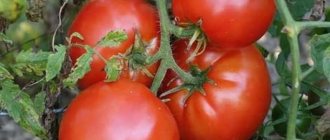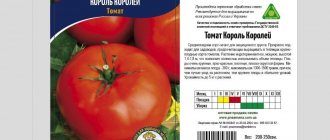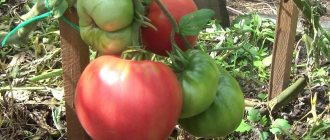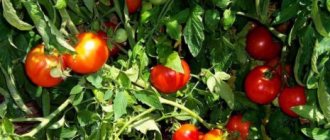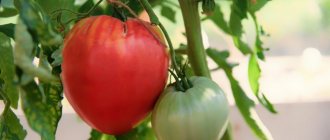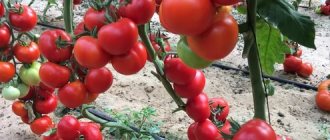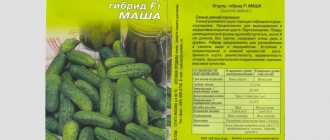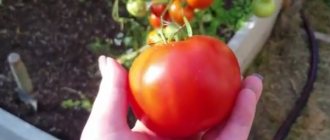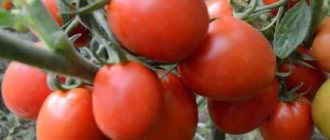Growing difficulties
Hybrid Malva f1 is demanding on soil quality. To prevent the plant from entering the stage of vegetative growth (fatification), when the green mass is actively growing and the number of ovaries is decreasing, the soil is enriched with humic substances (peat, sapropel, brown coal). This is done before planting seedlings, because then it is very difficult to change the composition of the soil.
What are the consequences of fatliquoring for plants? Fruiting is significantly reduced, which negatively affects the profitability of cultivation. Irrigation of bushes with growth stimulants containing sodium humate and fertilizing with superphosphate helps to correct the situation.
Watch the video about the fight against fattening of tomatoes at the end of the article.
Description of the hybrid
Hybrid Malva f1 appeared on the market recently. It was included in the State Register of Plants of the Russian Federation in 2022. The culture is intended for planting in open and closed ground. The bushes are medium-leaved and require pinching and formation into 1-2 stems.
In the photo - Malva f1 tomatoes.
Distinctive features are presented in the table.
| Indicators | Characteristic |
| Weight | 160–190 g |
| Form | The fruits are heart-shaped, slightly ribbed, with a sharp nose, reminiscent of garden strawberries. |
| Coloring | Ripe tomatoes are bright red. |
| Leaves | Medium size, green. |
| Inflorescence | Simple with 4–6 slots. |
| peduncle | With articulation. |
| Taste qualities | The taste is sweet, with a pleasant sourness. |
| Skin | Dense and elastic, does not crack. |
| Height | The bushes are indeterminate and grow up to 1.8 m. |
| Ripening period | 90–92 days from the moment of germination. |
| Productivity | 21–22 kg per 1 m². |
| Sustainability | To Alternaria and mosaic virus. |
Harvesting and application
The first harvest is harvested approximately 3 months after emergence. Tomatoes are used for pickling, salting, making adjika, juice, sauces, and pastes.
The fruits are good fresh as part of light vegetable salads.
Tomato Malvina
Early ripening (85-100 days from germination to ripening), indeterminate, racem variety of cherry tomatoes for greenhouses and open ground.
Bush 1.5-1.8 meters high, depending on growing conditions. The plant requires staking to a support and pinching. The best results were obtained when forming a bush with 2 stems. The leaves of this tomato are medium-sized, green, and of the usual type. The inflorescence is simple, with 12-15 fruits.
Basic qualities of fruits
The fruits are round, smooth, dense, raspberry-colored at maturity, weighing 15-25 grams, juicy, good taste. These tomatoes are universal in purpose - suitable for both fresh consumption and canning.
The Malvina tomato variety is included in the State Register of the Russian Federation for cultivation in open ground and under film covers in private household plots.
Originator: Poisk company.
Features of cultivation, planting and care
Sowing the seeds of this variety of tomatoes for seedlings is carried out 55-60 days before the intended planting in the ground. Seedlings dive at the stage of two true leaves. When planting seedlings in a permanent place per 1 sq. m area it is recommended to place up to 3 plants, when forming into 1 stem - up to 4.
Further care for tomatoes consists of timely watering, weed removal, pinching, fertilizing (if necessary) and preventive measures to protect the crop from diseases and pests.
If you grew Malvina tomatoes, please write whether you liked them or not. What was the yield and taste of the fruits like under your climatic conditions? How do you rate the disease resistance of this variety? If possible, attach a photo of the entire bush or individual fruits you grew.
Your reviews of the Malvina tomato and additions to the description will help many gardeners evaluate this variety objectively and decide whether it is worth planting or not.
Growing and caring for tomatoes
The agricultural technology of Malva f1 tomatoes is not much different from the cultivation of other hybrids. Care is organized according to the standard scheme: preparation of the substrate, sowing, growing seedlings, planting in open or closed ground, caring for plants.
Sowing seeds
Malva f1 tomatoes are cultivated in all regions of Russia. Sowing of seeds approximately begins 55–65 days before planting in the soil. Shoots appear in 5–10 days. In order not to overexpose seedlings on the windowsill, it is important to know when spring frosts end.
Sowing seeds for seedlings for open ground begins:
- in the southern regions: late February – early March;
- in the central regions: mid-March – early April;
- in the northern regions: the first and second ten days of April.
If planting in greenhouses is planned, sowing is carried out 2-3 weeks earlier.
Hybrid Malva f1 seeds do not need to be disinfected or germinate , but disinfecting the soil for seedlings will not be superfluous. This applies to soil from the garden and ready-made substrate for tomatoes from flower shops. The soil is calcined in the oven at a temperature of 200 ° C for 15 minutes and left to cool. The second popular method is disinfection with a strong solution of potassium permanganate.
Experienced gardeners recommend postponing sowing for 10 days and waiting for beneficial bacteria to appear in the soil . Then the prepared container is filled with a damp substrate and grooves 1 cm deep are made. The seeds are sown at a distance of 2 cm, covered with a small layer of soil on top and covered with film. The optimal germination temperature is +25 °C.
Seedling care
The containers are placed in a warm place and await germination. The film is removed once a day for 10–15 minutes to ventilate the soil. After the first leaves appear, the pots are taken to the most illuminated place. Window sills on the south side are ideal. A phytolamp is used as an additional light source.
The seedlings are watered at the root as the soil dries. To avoid damaging the delicate sprouts, use a pipette or syringe without a needle.
As soon as warm, sunny weather sets in, the seedlings are transferred to fresh air. For the first time, 5 minutes is enough. Every day the time is gradually increased by 5 minutes.
Seedlings are fertilized every 2 weeks after germination. An organic fertilizer based on bird droppings is best.
Picking into peat or plastic glasses is carried out after the appearance of 2-3 true leaves.
Planting seedlings
After the seedlings produce the first flower clusters, count 10–15 days and begin to prepare the soil for transferring the sprouts. The soil is dug up, loosened and disinfected with boiling water or a solution of potassium permanganate. The holes are dug to a depth of 15–20 cm. No more than 4 bushes are planted per square meter. The distance between seedlings is left 30–40 cm.
Reference . The best soil for tomatoes is black soil mixed with peat.
Plant seedlings on a cloudy day or in the evening. The soil is watered with warm, settled water.
Tomato care
Caring for Malva tomatoes is standard. The plant is unpretentious and only needs periodic weeding, moderate watering and fertilization.
Indeterminate bushes must be pruned, forming 1-2 stems that grow up to 2 meters and require garter.
Mulching the soil with peat, hay or sawdust allows you to reduce the amount of weeding and watering, as it stops the growth of weeds and retains moisture in the soil.
2-3 weeks after planting, the seedlings begin to be fed. This is necessary to strengthen the plants. For the first time, nitrogen is used in combination with phosphorus and potassium.
Take note of several options for combined fertilizers (calculated for 10 liters of water):
- 500 ml liquid mullein, 1 tbsp. l. nitrophoska;
- 500 ml chicken manure, 1 tbsp. l. superphosphate, 1 tsp. potassium sulfate;
- 50 g of ash, 30 g of superphosphate, 3 g of boric acid, 3 g of manganese sulfate, 1 liter of mullein.
From the moment the ovaries appear, they switch to potassium-phosphorus supplements (calculation per 10 liters of water):
- 500 g of ash;
- 1 tbsp. l. superphosphate, 1 tsp. potassium sulfate;
- 2 tbsp. l. ash, 1 tbsp. l. superphosphate;
- 1 tbsp. l. nitrophoska, 1 tsp. potassium humate;
- 10 g potassium nitrate, 25 g magnesium sulfate.
Reference . The rules for caring for Malva tomatoes growing in greenhouses and outdoors are no different.
Diseases and pests
Hybrid Malva f1 is resistant to many viral diseases of tomatoes. To prevent late blight, bushes are treated with various preparations: “Ordan”, “Topaz”, “Fundazol”, “HOM”, “Tiovit Jet”.
Folk remedies for combating late blight have proven themselves to be excellent:
- garlic infusion;
- kefir and salt sprays;
- milk with iodine;
- ash;
- infusion of tinder fungus;
- winding the roots with copper wire.
The first treatment is carried out after the appearance of 4–6 true leaves, the next – after 7–10 days. Treatment is stopped 20 days before harvest.
Confidor helps get rid of whiteflies and aphids. Slugs are afraid of lime, ash and tobacco dust. The fight against spider mites is carried out using a soap solution or garlic infusion.
Description of the hybrid
Hybrid Malva f1 appeared on the market recently. It was included in the State Register of Plants of the Russian Federation in 2022. The culture is intended for planting in open and closed ground. The bushes are medium-leaved and require pinching and formation into 1-2 stems.
In the photo - Malva f1 tomatoes.
Distinctive features are presented in the table.
| Indicators | Characteristic |
| Weight | 160–190 g |
| Form | The fruits are heart-shaped, slightly ribbed, with a sharp nose, reminiscent of garden strawberries. |
| Coloring | Ripe tomatoes are bright red. |
| Leaves | Medium size, green. |
| Inflorescence | Simple with 4–6 slots. |
| peduncle | With articulation. |
| Taste qualities | The taste is sweet, with a pleasant sourness. |
| Skin | Dense and elastic, does not crack. |
| Height | The bushes are indeterminate and grow up to 1.8 m. |
| Ripening period | 90–92 days from the moment of germination. |
| Productivity | 21–22 kg per 1 m². |
| Sustainability | To Alternaria and mosaic virus. |
Advantages and disadvantages
Hybrid Malva f1 has the following advantages:
- early ripening in open and closed ground;
- high productivity regardless of the place of growth;
- attractive fruit shape;
- small sizes allow tomatoes to be used for canning;
- high taste qualities;
- excellent keeping quality;
- possibility of transportation over long distances;
- resistance to viral diseases of nightshades.
There are not many disadvantages to the hybrid:
- the need for gartering and bush formation;
- active growth of green mass when planting in low-nutrient soil.
Growing difficulties
Hybrid Malva f1 is demanding on soil quality. To prevent the plant from entering the stage of vegetative growth (fatification), when the green mass is actively growing and the number of ovaries is decreasing, the soil is enriched with humic substances (peat, sapropel, brown coal). This is done before planting seedlings, because then it is very difficult to change the composition of the soil.
What are the consequences of fatliquoring for plants? Fruiting is significantly reduced, which negatively affects the profitability of cultivation. Irrigation of bushes with growth stimulants containing sodium humate and fertilizing with superphosphate helps to correct the situation.
Watch the video about the fight against fattening of tomatoes at the end of the article.
Varietal characteristics of mallow f1 tomatoes - Construction site
Monoculture in a greenhouse. Tomato "Malva".
Tomato “Malva” is distinguished by early ripening, high transportability, and high taste. And, of course, the shape of the fruit, which has a “spout,” makes this variety very attractive in the eyes of buyers.
Like other tomatoes, this hybrid loves fertile soil with a high content of humic substances, and in case of problems with fertility, so-called “fatification” may occur - a shift in development to vegetative growth - a gain of green mass, and, consequently, a significant reduction in the number of fruits. It is very difficult to combat this phenomenon, since it is no longer possible to change the composition of the soil after planting the seedlings.
In this case, the productivity of tomato is significantly reduced, and this is reflected in the income of farmers.
note
Semenyuk Vadim Anatolyevich - (Rostov Region, Stanitsa Krivyanskaya - Urozhay stores) has extensive experience in growing tomatoes. In 2022, he was the first in the village of Krivyanskaya to decide to test the Reasil Soil Improver to restore soil fertility.
However, before the products appear on the shelves of Harvest stores, the seller wants to be sure that he is offering his customers truly effective, safe, environmentally friendly products.
That is why Vadim Anatolyevich personally tested the drug on Malva tomatoes in summer-autumn rotation.
At the first stage, on August 30, 2022, control observations showed that the Malva tomato is “fatten”, blooms poorly, the fruit mass does not develop, and the top has massive greenery.
Reviews
Despite the novelty of the Malva f1 hybrid, many have managed to appreciate its advantages.
Vadim, Volgodonsk, Rostov region : “We started growing the Malva tomato variety last year. I collected the harvest in buckets and didn’t know what to do with it. He sold, gave away, and stocked up on supplies for several years to come. The culture is absolutely unpretentious in care. For the sake of experiment, I planted it in a film greenhouse and in the garden - the result was the same.”
Irina, Gorokhovets, Vladimir region: “I bought Malva f1 seeds out of curiosity last year. The description states that the tomatoes are suitable for growing in any conditions. I planted several bushes in the greenhouse. The result exceeded all expectations. A very prolific crop, easy to care for, the main thing is to water, fertilize and protect from pests in moderation. Tomatoes have an interesting shape, with pointed noses. The taste is excellent, sweet and sour. The tomatoes were eaten fresh and pickled.”
Resistance to diseases and pests
The Turkish super early hybrid can hardly be called very resistant to diseases and pests. Due to its rapid maturation, it is not susceptible to late blight, but may be vulnerable to powdery mildew and fusarium wilt, tobacco mosaic virus. It is recommended to carry out preventive treatment of bushes in open ground every 2 weeks from the moment of flowering. This will protect the plants throughout the growing season.
Among insect pests, the main danger is aphids. Whiteflies can also be found in greenhouses. In open ground, do not forget about collecting the Colorado potato beetle and spraying the bushes against it. Insecticidal protection measures should be applied at least once every 3 weeks.
Treatment and prevention against diseases and pests
Diseases and pests of tomatoes in a greenhouse When growing tomatoes in a greenhouse, diseases often occur due to temperature disturbances and excessive humidity. The most common diseases are fungal diseases (late blight, cladosporiosis, rot). More details
Diseases and pests of tomatoes in open ground Control of diseases and pests of tomatoes in open areas can be quite difficult. This is because nightshades are exposed to a wide variety of pathogens and insect pests. More details
Late blight
Powdery mildew
Apical rot
Cladosporiosis
Gray rot
Tobacco mosaic virus

